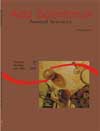<b>Genetic variability estimation of Nile tilapia strains (<em>Oreochromis niloticus</em>) using the RAPD technique</b> - DOI: 10.4025/actascianimsci.v27i1.1236
Abstract
Genetic variability estimation is highly important in order to achieve genetic improvement. The present experiment aims at estimating the genetic divergence and variability of the Nile tilapia strains (Oreochromis niloticus), Bouaké and Chitralada, in two breeders offsprings, using the Random Amplified Polymorphic DNA (RAPD). Twenty animals from each strain were used. The Jaccard similarity coefficients matrix was used for both designing a dendrogram and determining the genetic divergence of the strains, using Mantel’s test. The genetic variability was estimated by Shannon’s index and the percentage of polymorphic loci. Bouaké and Chitralada’s strains formed different groups. The former strain showed lower genetic divergence and variability in relation to the latter one. The two breeders offsprings had similar genetic variability in both strainsDownloads
Download data is not yet available.
Published
2008-03-20
How to Cite
Povh, J. A., Moreira, H. L. M., Ribeiro, R. P., Prioli, A. J., Vargas, L., Blanck, D. V., Gasparino, E., & Streit Jr, D. P. (2008). <b>Genetic variability estimation of Nile tilapia strains (<em>Oreochromis niloticus</em>) using the RAPD technique</b> - DOI: 10.4025/actascianimsci.v27i1.1236. Acta Scientiarum. Animal Sciences, 27(1), 1-10. https://doi.org/10.4025/actascianimsci.v27i1.1236
Issue
Section
Animal Breeding and Reproduction
DECLARATION OF ORIGINALITY AND COPYRIGHTS
- I Declare that current article is original and has not been submitted for publication, in part or in whole, to any other national or international journal.
The copyrights belong exclusively to the authors. Published content is licensed under Creative Commons Attribution 4.0 (CC BY 4.0) guidelines, which allows sharing (copy and distribution of the material in any medium or format) and adaptation (remix, transform, and build upon the material) for any purpose, even commercially, under the terms of attribution.
Read this link for further information on how to use CC BY 4.0 properly.
0.9
2019CiteScore
29th percentile
Powered by 








































